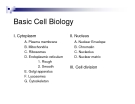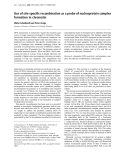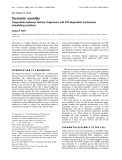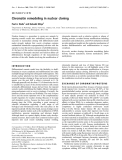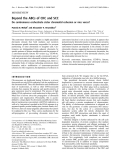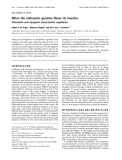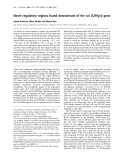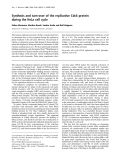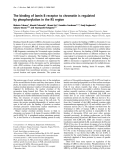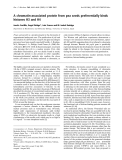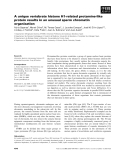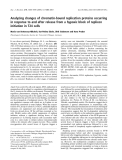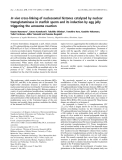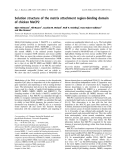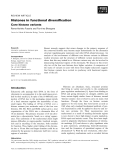
Chromatin
-
Phát triển là quá trình kiểm soát sự biểu hiện gen, quá trình điều hòa phức tạp về cơ chế, cơ bản có 5 mức độ: 1- Sự xoắn của NST (Chromatin Packing) 2- Kiểm soát sự phiên mã (Transcriptional Control) 3- Điều hòa hậu phiên mã (Posttranscriptional) [Nhân tế bào (Nuclear levels)] 4- Kiểm soát sự giải mã (Translational Control) 5- Điều hòa hậu giải mã (Posttranslational Control) [Cytosol (Cytoplasmic levels)] Sự điều hòa phiên mã bởi những phân tử protein,yếu tố phiên mã (transcription factors -TF). Các phân tử protein này luôn hiện diện trong tế bào và bám...
 62p
62p  bichtram1910
bichtram1910
 22-05-2012
22-05-2012
 250
250
 38
38
 Download
Download
-
Basic Cell Biology I. Cytoplasm A. Plasma membrane B. Mitochondria C. Ribosomes D. Endoplasmic reticulum 1. Rough 2. Smooth E. Golgi apparatus F. Lysosomes G. Cytoskeleton II. Nucleus A. Nuclear Envelope B. Chromatin C. Nucleolus D. Nuclear matrix III. Cell division .© 2002 by Bruce Alberts, Alexander Johnson, Julian Lewis, Martin Raff, Keith Roberts, and Peter Walter. .Asymmetrical arrangement of phospholipids in plasma membrane ATP-dependent phospholipid translocase .Molecular Cell Biology, Lodish et al., 4th edition. .Figure 2—1.
 68p
68p  whitedaisy1010
whitedaisy1010
 26-02-2013
26-02-2013
 63
63
 12
12
 Download
Download
-
Bài giảng Những điểm mới trong điều trị viêm gan B mạn hiện nay trình bày các nội dung chính sau: Lược qua về thực hành điều trị hiện nay, những hiểu biết quan trọng về nhiễm HBV,... Mời các bạn cùng tham khảo để nắm nội dung chi tiết của bài giảng.
 36p
36p  viguam2711
viguam2711
 06-01-2021
06-01-2021
 35
35
 2
2
 Download
Download
-
DNA transactions in eukaryotes require that proteins gain access to target sequences packaged in chromatin. Further, interactions between distinct nucleoprotein complexes are often required to generate higher-order structures. Here, we employed two prokaryotic site-specific recombination systems to investigate how chromatin packaging affects the assembly of nucleoprotein structures of different complexities at more than 30 genomic loci. The dynamic nature of chromatin permitted protein–DNA and DNA–DNA interactions for sites of at least 34 bp in length.
 7p
7p  system191
system191
 01-06-2013
01-06-2013
 55
55
 4
4
 Download
Download
-
Hypoxia interrupts the initiation of simian virus 40 (SV40) replication in vivo at a stage situated before unwinding of the origin region. After re-oxygenation, unwinding followed by a synchronous round of viral replication takes place. To further characterize the hypoxia-induced inhibition of unwinding, we analysed the binding of several replication proteins to the viral minichromosome before and after re-oxygenation.
 11p
11p  research12
research12
 01-06-2013
01-06-2013
 41
41
 4
4
 Download
Download
-
Chromatin is a highly dynamic structure that plays an essential role in regulating all nuclear processes that utilize the DNA template including DNA repair, replication, transcription and recombination. Thus, the mechanisms by which chromatin structures are assembled and modified are questions of broad interest. This minireview will focus on two groups of proteins: (a) histone chaperones and (b) ATPdependent chromatin remodeling machines, that co-operate to assemble DNA and histone proteins into chromatin....
 7p
7p  research12
research12
 01-06-2013
01-06-2013
 36
36
 4
4
 Download
Download
-
Nuclear receptors (NRs) are ligand-regulated, DNA-binding transcription factors that function in the chromatin environment of the nucleus to alter the expression of subsets of hormone-responsive genes. It is clear that chromatin, rather than being a passive player, has a profound effect on both transcriptional repression and activation mediated by NRs.
 9p
9p  research12
research12
 01-06-2013
01-06-2013
 32
32
 2
2
 Download
Download
-
Nuclear cloning is a procedure to create new animals by injecting somatic nuclei into unfertilized oocytes. Recent successes in mammalian cloning with differentiated adult nuclei strongly indicate that oocyte cytoplasm contains unidentified remarkable reprogramming activities with the capacity to erase the previous memory of cell differentiation. At the heart of this nuclear reprogramming lies chromatin remodeling as chromatin structure and function define cell differentiation through regulation of the transcriptional activities of the cells....
 4p
4p  research12
research12
 01-06-2013
01-06-2013
 43
43
 4
4
 Download
Download
-
The organization of DNA within eukaryotic cell nuclei poses special problems and opportunities for the cell. For example, assembly of DNA into chromatin is thought to be a principle mechanism by which adventitious general transcription is repressed. However, access to genomic DNA for events such as DNA repair must be facilitated by energy-intensive processes that either directly alter chromatin structure or impart post-translational modifications, leading to increased DNA accessibility.
 6p
6p  research12
research12
 01-06-2013
01-06-2013
 36
36
 4
4
 Download
Download
-
The centromere–kinetochore complex is a highly specialized chromatin domain that both mediates and monitors chromosome–spindle interactions responsible for accurate partitioning of sister chromatids to daughter cells. Centromeres are distinguished from adjacent chromatin by specific patterns of histone modification and the presence of a centromere-specific histone H3 variant (e.g. CENP-A). Centromere-proximal regions usually correspond to sites of avid and persistent sister chromatid cohesion mediated by the conserved cohesin complex.
 15p
15p  research12
research12
 01-06-2013
01-06-2013
 50
50
 4
4
 Download
Download
-
During the development of multicellular organisms, both transient and stable gene expression patterns have to be established in a precisely orchestrated sequence. Evidence from diverse model organisms indicates that this epigenetic program involves not only transcription factors, but also the local structure, composition, and modification of chromatin, which define and maintain the accessibility and transcriptional competence of the nucleosomal DNA template.
 6p
6p  research12
research12
 01-06-2013
01-06-2013
 33
33
 4
4
 Download
Download
-
To search for novel regulatory regions, we examined the features of chromatin structure in the rat B29/Ig-b gene and its flanking regions by determining DNase I hypersensitive sites (DHS) in plasmacytoma-derived Y3 cells. Six Y3 cellspecific DHS were detected at )8.6, promoter, +0.7, +4.4, +6.0, and +8.7 kb. The DHS at +4.4, +6.0, and +8.7 kb were present in the intergenic region between B29/Ig-b and growth hormone (GH) genes and were mapped inside conserved sequences in rat and humans.
 10p
10p  research12
research12
 01-06-2013
01-06-2013
 30
30
 4
4
 Download
Download
-
The human replication protein Cdc6p is translocated from its chromatin sites to the cytoplasm during the replication phase (S phase) of the cell cycle. However, the amounts of Cdc6p on chromatin remain high during S phase implying either that displaced Cdc6p can rebind to chromatin, or that Cdc6p is synthesized de novo. We have performed metabolic labeling experiments and determined that [35S]methionine is incorporated into Cdc6p at similar rates during the G1 phase and the S phase of the cell cycle. Newly synthesized Cdc6p associates with chromatin....
 7p
7p  research12
research12
 01-06-2013
01-06-2013
 41
41
 3
3
 Download
Download
-
Binding of lamin B receptor (LBR) to chromatin was studied by means of an in vitro assay system involving recombinant fragments of human LBR and Xenopus sperm chromatin. Glutathione-S-transferase (GST)-fused proteins including LBR fragments containing the N-terminal region (residues 1–53) and arginine-serine repeat-containing region (residues 54–89) bound to chromatin. The binding of GST-fusion proteins incorporating the N-terminal and arginine-serine repeat-containing regions to chromatin was suppressed by mild trypsinization of the chromatin and by pretreatment with a DNA solution....
 11p
11p  research12
research12
 01-06-2013
01-06-2013
 30
30
 4
4
 Download
Download
-
Pisum sativump16 is a protein present in the chromatin of ungerminated embryonic axes. The purification of p16 and the isolationof a cDNAclone ofpsp54, the gene encoding its precursor have been recently reported [Castillo, J., Rodrigo, M. I.,Ma´rquez, J. A., Zu´n˜iga, AandFranco, L. (2000)Eur. J.Biochem.267, 2156–2165]. In thepresentpaper,wepresent data showing that p16 is a nuclear protein.
 8p
8p  research12
research12
 23-04-2013
23-04-2013
 38
38
 2
2
 Download
Download
-
Protamine-like proteins constitute a group of sperm nuclear basic proteins that have been shown to be related to somatic linker histones (histone H1 family). Like protamines, they usually replace the chromatin somatic his-tone complement during spermiogenesis; hence their name. Several of these proteins have been characterized to date in invertebrate organisms, but information about their occurrence and characterization in vertebrates is still lacking.
 14p
14p  tumor12
tumor12
 20-04-2013
20-04-2013
 42
42
 3
3
 Download
Download
-
It was shown previously [Riedinger, H. J., van Betteraey-Nikoleit, M & Probst, H. (2002)Eur. J. Biochem.269, 2383–2393] that initiation ofin vivo SV40 DNA replication is reversibly suppressed by hypoxia in a state where viral minichromosomes exhibit a nearly complete set of repli-cation proteins. Reoxygenation triggers fast completion and post-translational modifications.
 11p
11p  tumor12
tumor12
 20-04-2013
20-04-2013
 31
31
 2
2
 Download
Download
-
A histone heterodimer, designated as p28, which contains an N e (c-glutamyl)lysine cross-link between Gln9 of histone H2B and Lys5 or Lys12 of histone H4, is present in starfish (Asterina pectinifera) sperm. Treatment of spermnuclei with micrococcal nuclease produced soluble chromatin, which was size-fractionated by sucrose-gradient centrifugation to give p28-containing oligonucleosome and p28-free mono-nucleosome fractions, indicating that the cross-link is inter-nucleosomal.
 10p
10p  tumor12
tumor12
 20-04-2013
20-04-2013
 42
42
 4
4
 Download
Download
-
Báo cáo khoa học: Solution structure of the matrix attachment region-binding domain of chicken MeCP2
Methyl-CpG-binding protein 2 (MeCP2) is a multifunc-tional protein involved in chromatin organization and silencing of methylated DNA. MAR-BD, a 125-amino-acid residue domain of chicken MeCP2 (cMeCP2, origin-ally named ARBP), is the minimal protein fragment required to recognize MAR elements and mouse satellite DNA. Here we report the solution structure of MAR-BD as determined by multidimensional heteronuclear NMR spectroscopy.
 8p
8p  tumor12
tumor12
 20-04-2013
20-04-2013
 37
37
 2
2
 Download
Download
-
Recent research suggests that minor changes in the primary sequence of the conserved histones may become major determinants for the chromatin structure regulating gene expression and other DNA-related processes. An analysis of the involvement of different core histone variants in different nuclear processes and the structure of different variant nucleosome cores shows that this may indeed be so. Histone variants may also be involved in demarcating functional regions of the chromatin.
 20p
20p  fptmusic
fptmusic
 12-04-2013
12-04-2013
 38
38
 4
4
 Download
Download
CHỦ ĐỀ BẠN MUỐN TÌM









